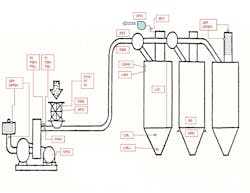Benefits of pneumatic conveying system instrumentation
Historically, straightforward pneumatic conveying systems have been weak with respect to using instrumentation and the trending of operational data to benefit multiple areas of potential opportunity. Equipment suppliers have tended to offer minimal instrumentation, typically only a pressure indicator showing the discharge pressure (as PSIG) of a blower or compressor on a pressure conveying system or at the inlet of the vacuum producer on a vacuum conveying system. Suppliers of dust collectors, bin vent filters or filter receivers also typically provide a differential pressure indicator to monitor the differential pressure across the filter elements.
The level of instrumentation would be increased to address specific process or material concerns as part of the pneumatic conveying process. Examples include systems conveying materials such as polymer resins or food-grade products such as sugar, which are temperature sensitive, where the conveying air must be kept below a specific temperature threshold. On such systems, a thermowell with temperature probe monitors the air temperature on a real-time basis and, when the temperature approaches the threshold, heat exchangers are turned on to cool the airstream.
Differential pressure transmitters
In the case of a differential pressure indicator, as previously mentioned, the visual indication would typically provide feedback to an operator, who would manually adjust the timer setting to increase or decrease the pulse/dwell time of the filter cleaning cycle to maintain the desired differential pressure range.
With the addition of a differential pressure transmitter, the cleaning cycle can be adjusted on a real-time basis to maintain the desired differential pressure range. The transmitter can also turn the cleaning cycle completely off and back on based on the differential pressure value, so cleaning only occurs when absolutely necessary rather than continuously on a timer-based control, which can increase filter life and reduce operating costs.
Variable frequency drives
In more recent times, pneumatic conveying system blower packages and line chargers (which introduce material into the moving airstream) have used variable frequency drives independently as well as in conjunction with each other to optimize the system’s velocity profile, which can benefit several aspects of the system performance, including:
- Reduced energy use, contributing to lower operating costs;
- Reduced particle damage to friable materials, which maintains product integrity;
- Reduced wear and tear to the conveying line and elbows when handling an abrasive material;
- The ability to optimize the air-to-material ratio and velocity profile for each material on systems that are intended to handle multiple materials, especially when the materials have different properties. The fully optimized relationships for each material can be stored as part of the system operating narrative, so that when a specific material is selected, the proper line charge and gas supply equipment can be set accordingly.
Monitoring trending data
If a system is operated in a framework of control that has the ability to trend specific information and keep that information so it can be recalled when necessary, this is an extremely effective way to troubleshoot an existing system when problems arise. Simply going back to look at trend data for the key operating parameters when the system was running well and comparing that information to what is currently happening can provide guidance as to where to start the troubleshooting process. This can minimize costly downtime and lost production as well as wasted worker time.
Many industries are finding it difficult to keep a fully staffed workforce. In those cases, an important area of the operation, preventative maintenance (PM), often suffers. By installing the right instrumentation to collect a pneumatic conveying system’s key performance indicators and using artificial intelligence to analyze that information, processors can realize several benefits, including:
- Recognizing a developing problem in its earliest stages and making operators aware of the situation and the speed at which the problem is growing, as well as potential steps that can be taken to prevent a catastrophic event from occurring;
- Identifying operating hours for machinery that typically needs rebuilding or lubrication intervals, etc., and generating PM reports to let the maintenance staff know that work will soon be required so they can plan maintenance proactively rather than just reacting when an unscheduled shutdown occurs;
- Monitoring key operating parameters so that, when a problem is starting to develop, operators can begin searching the available database of past performance to look for previous case studies/solutions and their root causes. This use of information captured within the system operating narrative can minimize the expense and time required to troubleshoot and solve a problem that has been previously addressed and documented.
Inventory management
Inventory instrumentation can be important for optimizing the performance of an existing system or for establishing a benchmark for future design. Keeping track of material inventory and validating material used as part of recipe formulations or ingredients in batch formulations is easily accomplished.
Rising costs and longer lead times for raw materials have made it more important than ever to track exactly what materials are in the plant, where they are located and when they should be reordered. Instruments are available that can track bulk material inventory levels on a real-time basis or on a less frequent basis using point-level instrumentation.
As bulk materials are loaded into bulk carriers such as trucks or rail cars or more consumer friendly packages such as boxes, cans and bottles, their specific barcoding provides ample opportunity to capture the information required to automatically manage inventory levels of the finished products, what raw materials and process operations need to be scheduled for the next production run, and the inventory levels of the bottles, boxes and bags being used as part of the loadout operations.
Instrumentation options
Figure 1 shows a piping and instrumentation diagram (P&ID) for a hypothetical pneumatic conveying system indicating the available instrumentation options. No system would ever need to be instrumented with all of the options shown because several of the options have overlapping functionality. The best instrumentation choices for any given system depend on the material being conveyed and the application.
The best way to determine if an existing system is a good candidate for added instrumentation is to consider how much downtime is occurring, how many personnel hours are being expended to find and analyze problems, and then how much more time and costs are being expended to implement solutions. If you have a system that is experiencing those conditions, that would be a good place to start adding instrumentation and updating the system operating narrative or software to incorporate the new information that is available.
Jack Hilbert is principal consultant for Pneumatic Conveying Consultants, LLC. He holds a BS and an MS in mechanical engineering from Penn State University, State College, PA, and has more than 48 years of experience in the application, design, detailed engineering, installation and operation of pneumatic conveying systems.
Pneumatic Conveying Consultants, LLC.
About the Author

Jack Hilbert
Principal Consultant at Pneumatic Conveying Consultants LLC
Jack Hilbert is principal consultant for Pneumatic Conveying Consultants, LLC. He holds BS and MS degrees in mechanical engineering from Penn State University, State College, PA, and has more than 50 years of experience in the application, design, detailed engineering, installation, and operation of pneumatic conveying systems.

